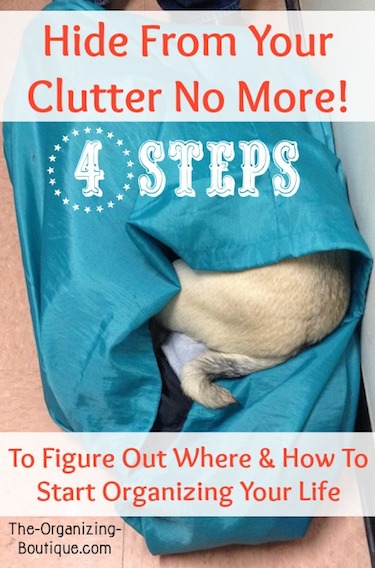How To Get Organized - Where To Start Organizing
This post may contain affiliate links. This means if you click on the link and purchase
the item, I will receive an affiliate commission. More here: Disclaimer & Privacy Policy
If you're having trouble figuring out how to get organized, then you've come to the right place.
You are not alone! As a
professional organizer, I frequently hear, "I just don't know where to start organizing." The sight of growing clutter
becomes very overwhelming and paralyzing making it difficult to get organized...let alone identifying the place the start.
The following will help you decide where to start organizing and the next steps to take in order to reach your goal of getting organized. Enjoy!
Where To Start & How To Get Organized In 4 Easy Steps
Before you do anything, it's important to have a clear mind and start your journey organizing from the inside out. Getting organized means living consciously and being able to recognize how you think about things as well as mental road blocks. Only then can you identify the roots of problems, learn how to set goals successfully and start overcoming procrastination.
If you're mind is clear and open, then you are ready to get organized. This is where to start...
1. IDENTIFY
The first thing you need to do when trying figure out how to get organized is to look around your home or office and
identify the biggest problem areas.
Do this by asking yourself
questions like the following. If you need to write it down, print out this page and fill in the answers below the questions.
What area affects me the most?
What area slows down my morning routine the most?
What area costs me the most money by not being organized?
What area do I find the most frustrating?
Let's say you selected the kitchen as your biggest problem area. If you chose another space, simply apply the following steps to the room or area you decided on.
2. ANALYZE
The next step is to outline why your biggest problem area is your biggest problem area.
Is it a dumping ground?
Does it take too long to find items in this area?
Does this area have an actual purpose?
For example, if your problem area is the kitchen, you might identify that too many random items get dumped there because it is such a high traffic room.
3. SOLVE
Next, come up with a solution.
It is important to work with, rather than against, your natural habits. It is much easier and more effective to provide organizing ideas that don't require changing a routine that works for you or committing to a new habit.
Let's continue with the above example. If the kitchen is the biggest problem area because it is a dumping ground for random items, then create homes for those items in the kitchen.
For
instance, let's say your children do their homework in the kitchen, thus
their backpacks end up littering the floor. Install some hooks
underneath the counter or somewhere the children can reach and implement
a rule that backpacks must be hung up.
4. ORGANIZE
Now
that you've identified your biggest problem area, analyzed why it is so
and come up with a solution, it's time to organize it (click link below).
Then Repeat
Once you've organized your biggest problem area, repeat the steps above to organize the next prioritized space.











Facebook Comments